
What Are the Different Types of Beds in Nursing?
📋 KEY TAKEAWAYS
| Bed Type | Key Features | Best For |
|---|---|---|
| Standard Hospital Beds | Electric or manual controls, adjustable head/foot | General patient care, basic positioning needs |
| Low/Hi-Lo Beds | Variable height (7"-30"), fall prevention | Fall-risk patients, transfer assistance |
| Bariatric Beds | Reinforced frame, 500-1000 lb capacity, wider | Larger patients, 350+ lbs |
| Air/Pressure Relief Beds | Dynamic pressure redistribution | Pressure ulcer prevention/treatment |
| Specialty Beds | Trendelenburg, lateral rotation, circulatory support | Specific medical conditions |
Most Versatile Option: Icare Adjustable Electric Home Hospital Bed IC333 – Full electric with height adjustment
Budget Option: Costcare Semi-Electric Bed B120C – Affordable with essential functions at $1,068
For Fall Prevention: Ultra Low Hospital Bed Medacure ULB3.9 – Ultra-low 3.9" height capability
What are the different types of beds in nursing? Nursing facilities utilize a wide range of specialized beds designed to address specific patient needs, from basic positioning to advanced therapeutic functions. These specialized hospital beds play a crucial role in patient care, safety, and recovery across various healthcare settings.
The most versatile option for most nursing applications is the Icare Adjustable Electric Home Hospital Bed IC333, which combines full electric positioning with height adjustment capabilities and a design that works well in both institutional and home care settings.
In this comprehensive guide, we'll explore the main categories of hospital beds, their specific features, and which situations each type serves best. Understanding these differences helps healthcare providers, caregivers, and family members select the optimal bed for patient needs, whether in a hospital, long-term care facility, or home setting.
Standard Hospital Beds
Standard hospital beds form the foundation of nursing bed options, providing essential functionality for general patient care.
Full Electric Hospital Beds
Full electric hospital beds represent the most common and versatile standard option, featuring:
- Motorized adjustments: Electric motors control head, foot, and height positions
- Remote control operation: Allows patients and staff to make adjustments easily
- Height adjustability: Typically ranges from 15"-30" from floor to mattress platform
- Head elevation: Usually 0-60 degrees for respiratory support, feeding, and comfort
- Foot elevation: Typically 0-40 degrees for edema management and pressure relief
The Costcare Full Electric Hospital Bed B135C exemplifies this category at $1,298, offering reliability and complete electric functionality.
Full electric beds benefit:
- Patients with limited mobility who need frequent position changes
- Staff requiring ergonomic positioning for care activities
- Settings where patient independence is encouraged
- Situations requiring varied therapeutic positions
- Environments where ease of use is prioritized
Semi-Electric Hospital Beds
Semi-electric beds offer a balance between functionality and cost-effectiveness:
- Partial motorization: Electric motors for head and foot adjustments only
- Manual height adjustment: Requires crank operation to raise or lower bed height
- Cost savings: Typically 20-30% less expensive than fully electric models
- Reduced complexity: Fewer electrical components mean fewer potential failures
- Lighter weight: Often weighing less than full electric models
The Costcare Semi-Electric Bed B120C offers this balanced approach at $1,068.
Semi-electric beds are ideal for:
- Budget-conscious facilities
- Situations where height adjustment is infrequent
- Patients who primarily need head and foot positioning
- Backup beds in case of power outages (manual height function)
- Home care with limited electrical requirements
Manual Hospital Beds
Manual hospital beds, while less common in modern nursing facilities, still serve specific purposes:
- Hand-crank operation: All adjustments require manual cranking
- No electrical components: Functions during power outages without backup systems
- Maximum simplicity: Minimal parts to malfunction
- Lowest cost option: Typically 40-50% less than full electric models
- Lightweight construction: Easier to transport and maneuver
Manual beds work best in:
- Areas with unreliable electricity
- Extremely budget-limited situations
- Temporary or backup use scenarios
- Settings where simplicity is valued over convenience
- Locations where electrical safety is a concern
Low and Hi-Lo Hospital Beds
Height-adjustable beds serve critical functions in fall prevention and caregiver ergonomics.
Ultra-Low Beds
Ultra-low beds specialize in fall protection through extreme height range:
- Minimal height: Can lower to 3.9"-7" from floor to mattress platform
- Fall injury reduction: Minimizes potential injury height if falls occur
- Full range capability: Still raises to standard working heights (24"-30")
- Side rail options: Compatible with various rail configurations
- Exit alarms: Often include bed exit notification systems
The Ultra Low Hospital Bed Medacure ULB3.9 leads this category with its industry-leading 3.9" minimum height ($2,240-$2,440).
Ultra-low beds are essential for:
- High fall-risk patients
- Dementia and confusion cases
- Patients on certain medications affecting balance
- Rehabilitation settings
- Facilities focused on minimizing restraint use
Standard Hi-Lo Beds
Standard hi-lo beds balance transfer safety with caregiver ergonomics:
- Versatile height range: Typically 7"-30" floor to mattress surface
- Transfer optimization: Can be set to chair height for lateral transfers
- Caregiver ergonomics: Raises to reduce back strain during care
- Mobility support: Proper height assists with independent transfers
- Floor lock systems: Stability during position changes
The Medacure Ultra Low Hospital Bed ULB7/30-CLS exemplifies this category with its 7"-30" range and locking system for $1,741.
Standard hi-lo beds work well for:
- General nursing populations with mixed needs
- Rehabilitation settings focusing on transfer training
- Facilities with varied caregiver heights
- Patients transitioning to greater independence
- Settings requiring frequent position changes for care
Bariatric Hospital Beds
Specialized beds designed for larger patients ensure safety, dignity, and proper care.
| Bariatric Bed Feature | Standard Beds | Bariatric Beds |
|---|---|---|
| Weight Capacity | 350-450 lbs | 500-1000+ lbs |
| Sleeping Surface Width | 36"-39" | 42"-60" |
| Frame Construction | Standard steel | Reinforced, heavy-duty |
| Motor Strength | Standard | Heavy-duty, dual motors |
| Side Rail Design | Standard | Reinforced, extended |
Standard Bariatric Beds
Standard bariatric hospital beds accommodate patients up to approximately 600 pounds:
- Reinforced frame: Heavy-duty construction for safety and durability
- Wider sleep surface: Typically 42"-48" compared to standard 36"
- Enhanced stability: Wider base and reinforced structure
- Powerful motors: Higher capacity lifting mechanisms
- Bariatric-specific side rails: Extended length and strength
The Full Electric Bariatric Hospital Bed Costcare B142C represents this category at $1,842.
Standard bariatric beds are ideal for:
- Patients weighing 350-600 pounds
- Settings with moderate bariatric populations
- Facilities requiring a balance of space efficiency and capacity
- Situations requiring regular bariatric care
- Environments where standard doorways limit maximum width
Heavy-Duty Bariatric Beds
Heavy-duty bariatric beds support the highest weight capacities with specialized features:
- Maximum capacity: Support for 750-1000+ pounds
- Extra-wide surfaces: 54"-60" width for comfort and positioning
- Advanced reinforcement: Maximum structural integrity
- Dual motor systems: Multiple motors for reliable positioning
- Expandable design: Some models offer adjustable width
The Costcare Bariatric Adjustable Hospital Bed B359 demonstrates these capabilities with its 54"-60" width options and 750 lb capacity for $3,457.
Heavy-duty bariatric beds are necessary for:
- Patients exceeding 600 pounds
- Specialized bariatric care units
- Settings focusing on morbid obesity treatment
- Facilities with accommodations for doorway width
- Bariatric surgery recovery areas
Expandable Bariatric Beds
Some bariatric beds feature adaptable width capabilities:
- Adjustable width: Can be modified from standard to bariatric dimensions
- Versatility: Serves multiple patient populations with one bed
- Space efficiency: Narrower when full width isn't needed
- Future-proofing: Adapts to changing facility needs
- Cost-effective: One bed serves multiple purposes
The Heavy Duty Hospital Bed Costcare B357 offers this adaptability with width options from 42"-48" for $3,142.
Expandable bariatric beds work well in:
- Facilities with varying bariatric populations
- Settings with space constraints
- Multi-purpose rooms
- Areas where patient size varies significantly
- Facilities seeking equipment versatility
Air and Pressure Relief Beds
Advanced hospital bed mattress systems focus on pressure ulcer prevention and treatment.
Alternating Pressure Systems
Alternating pressure systems actively redistribute pressure through cyclical inflation patterns:
- Air cell technology: Individual air chambers inflate and deflate cyclically
- Pressure redistribution: Continuously changes pressure points
- Adjustable cycle times: Can be modified for patient needs
- Multiple zones: Different body areas can receive varied support
- Integrated pumps: Quiet operation with pressure monitoring
These specialized mattress systems work with compatible hospital beds to provide advanced pressure management.
Alternating pressure systems benefit:
- Patients with existing pressure injuries
- Individuals at high risk for skin breakdown
- Long-term bedridden patients
- Post-surgical recovery with limited mobility
- Patients with poor circulation or sensation
Low Air Loss Systems
Low air loss systems focus on microclimate management in addition to pressure:
- Air circulation: Constant airflow beneath the patient
- Moisture management: Reduces humidity at skin-surface interface
- Temperature regulation: Helps maintain proper skin temperature
- Pressure distribution: Even support across the body
- Therapeutic surfaces: Often combined with other pressure technologies
The Medacure Pro Dynamic True Low Air Loss Hospital Bed Mattress exemplifies advanced therapeutic surface technology.
Low air loss systems are crucial for:
- Patients with moisture-related skin concerns
- Individuals with excessive perspiration
- High-risk patients requiring maximum intervention
- Long-term care situations
- Pressure ulcer treatment protocols
Integrated Air Fluidized Therapy
The most advanced pressure relief systems use fluidized air technology:
- Silicone bead suspension: Microscopic beads suspended by air
- Fluid-like surface: Creates minimal pressure against body tissues
- Maximum immersion: Distributes weight across entire contact area
- Temperature control: Maintains therapeutic surface temperature
- Minimal shear forces: Reduces friction during movement
These highly specialized systems are used in:
- Burn treatment centers
- Advanced wound care units
- Critical pressure ulcer management
- Specialized rehabilitation facilities
- Cases where traditional surfaces are insufficient
Specialty Function Beds
Certain medical conditions require beds with specific therapeutic capabilities.
Trendelenburg/Reverse Trendelenburg Beds
These beds offer specialized positioning for circulatory and respiratory conditions:
- Trendelenburg position: Feet elevated above head level for circulatory support
- Reverse Trendelenburg: Head elevated above feet for respiratory assistance
- Precise angle control: Exact positioning for therapeutic effect
- Medical-grade articulation: Maintains proper body alignment
- Programmable settings: Stores prescribed angles for consistency
The Trendelenburg Costcare Adjustable Medical Bed B337 provides these specialized positions for $1,675.
Trendelenburg-capable beds serve:
- Patients with circulatory insufficiency
- Individuals with significant edema
- Respiratory distress cases
- Post-surgical recovery for certain procedures
- Specialized medical protocols requiring precise positioning
Lateral Rotation Therapy Beds
Lateral rotation beds provide automated turning to prevent complications:
- Programmable rotation: Automatic side-to-side movement
- Customizable angles: Adjustable degree of rotation
- Timed intervals: Controlled frequency of position changes
- Pulmonary support: Helps prevent fluid accumulation in lungs
- Reduced manual turning: Decreases staff workload and injury risk
Lateral rotation systems like the Prius Lateral Alternating Pressure Mattress provide therapeutic rotation with pressure management.
Lateral rotation benefits:
- Pneumonia prevention
- Bedridden patients requiring regular turning
- Pulmonary complications
- Reduced caregiver strain
- Prevention of positional pressure injuries
Cardiac/Chair Position Beds
Some specialized beds focus on cardiac support through positioning:
- Cardiac chair position: Optimized angle for heart function
- Multi-articulation points: Creates proper seated position while in bed
- Leg elevation capability: Manages peripheral edema
- Respiratory optimization: Opens airways for improved breathing
- Cardiovascular support: Reduces cardiac workload
These specialized positions are available in beds like the Costcare Trendelenburg Adjustable Hospital Bed B730 at $4,300.
Cardiac position beds serve:
- Post-cardiac surgery patients
- Congestive heart failure cases
- Respiratory compromise situations
- Patients unable to tolerate flat positioning
- Long-term cardiopulmonary conditions
Specialized Support Surfaces and Mattresses
The hospital bed mattress is a crucial component of the complete bed system, with specialized options for different needs.
| Mattress Type | Key Features | Best For |
|---|---|---|
| Standard Foam | Basic support, moderate pressure relief | Short-term, low-risk patients |
| Multi-Zoned Foam | Varying density zones for targeted support | Moderate pressure risk, good mobility |
| Memory Foam | Conforms to body, reduces pressure points | Pain management, moderate risk |
| Gel Infused | Temperature regulation, pressure distribution | Heat-sensitive patients, comfort focus |
| Air/Foam Hybrid | Combines technologies for enhanced relief | High-risk patients with some mobility |
Standard and Multi-Zoned Foam Mattresses
Basic foam mattresses provide foundation-level support with important features:
- Articulation design: Segmented to bend with bed adjustments
- Pressure distribution: Provides basic weight distribution
- Waterproof covering: Fluid-resistant, antimicrobial materials
- Fire retardancy: Meets medical safety standards
- Durability: Designed for 24/7 clinical use
Multi-zoned options like the Emerald Hospital Bed Foam Mattress provide enhanced pressure distribution through varied foam densities.
Foam mattresses are suitable for:
- Short-term care situations
- Patients with good mobility
- Low to moderate pressure ulcer risk
- Budget-conscious applications
- General nursing populations
Memory Foam and Gel Technologies
Advanced foam technologies enhance pressure management capabilities:
- Body contouring: Memory foam adapts to individual body shape
- Weight distribution: Spreads pressure across larger surface area
- Temperature response: Some foams soften with body heat for better conformity
- Motion isolation: Reduces transfer of movement to sensitive areas
- Targeted support: Varied zones for different body regions
Hospital bed mattresses with memory foam provide enhanced comfort and pressure relief.
Memory foam mattresses serve:
- Patients with pain management needs
- Moderate pressure ulcer risk
- Longer-term care situations
- Individuals with sensitivity issues
- Cases requiring enhanced comfort without air systems
Integrated Mattress Systems
Some specialty beds feature fully integrated mattress systems:
- Unified design: Bed frame and support surface engineered together
- Optimized function: Perfect articulation with bed movement
- Simplified controls: Single control system for all functions
- Streamlined appearance: Less equipment complexity
- Advanced integration: All components work together seamlessly
Alternating pressure mattress systems like the Emerald Alternating Pressure Mattress - LAL System combine with compatible frames for complete therapeutic systems.
Integrated systems benefit:
- Specialized care units
- Complex patient needs
- Settings requiring maximum therapeutic effect
- Facilities seeking operational simplicity
- Advanced pressure management protocols
Our Top Recommendations for Nursing Settings
Based on comprehensive analysis, these hospital beds represent the best options for various nursing environments.
Best Overall: Icare Adjustable Electric Home Hospital Bed IC333
The Icare Adjustable Electric Home Hospital Bed IC333 represents the most versatile option applicable across most nursing scenarios with:
- Full electric operation: Complete control of all positions
- Height adjustability: Supports both fall prevention and caregiver ergonomics
- Residential appearance: Less institutional look for home-like environments
- Premium construction: Superior durability for long-term use
- Accessory compatibility: Works with full range of medical add-ons
Best for Fall Prevention: Ultra Low Hospital Bed Medacure ULB3.9
For maximum fall protection, the Ultra Low Hospital Bed Medacure ULB3.9 offers:
- Industry-leading 3.9" minimum height: Unmatched floor-level positioning
- Full electric capabilities: All adjustments easily controlled
- Caregiver-friendly: Still raises to proper working heights
- Compatible with rails: Works with various safety rail configurations
- Modern design: Balances clinical needs with aesthetic considerations
Best Value: Costcare Semi-Electric Bed B120C
For budget-conscious facilities, the Costcare Semi-Electric Bed B120C delivers:
- Essential electric functions: Powered head and foot adjustment
- Cost-effective design: $1,068 price point
- Manual height option: Reduces complexity while maintaining functionality
- Standard compatibility: Works with most accessories and mattresses
- Reliability: Proven performance record in nursing environments
Frequently Asked Questions
What is the difference between a hospital bed and a nursing home bed?
Hospital beds and nursing home beds are essentially the same, both featuring adjustable positioning and medical-grade construction. The term "nursing home bed" simply indicates long-term care application.
Can regular mattresses be used on nursing beds?
No, regular mattresses cannot be used on nursing beds. Hospital beds require specialized segmented mattresses designed to articulate with the frame's movements.
How often should nursing beds be replaced?
Nursing beds typically should be replaced every 8-10 years depending on usage, or when mechanical/electrical components fail despite proper maintenance.
Are all nursing beds height-adjustable?
Not all nursing beds have height adjustment. Full electric and hi-lo models offer this feature, while some basic models maintain fixed height.
What safety features are most important in nursing beds?
The most critical safety features include height adjustability, properly designed side rails, locking wheels, emergency controls, and weight capacity appropriate for the patient.
How do bariatric beds differ from standard nursing beds?
Bariatric beds feature reinforced frames, wider sleep surfaces (42"-60"), higher weight capacities (500-1000+ lbs), and stronger motors compared to standard 36" beds supporting 350-450 lbs.
Can air mattress systems be added to any nursing bed?
Most air mattress systems can be added to standard hospital beds, but verify compatibility between the specific mattress and bed frame dimensions and weight capacity.

















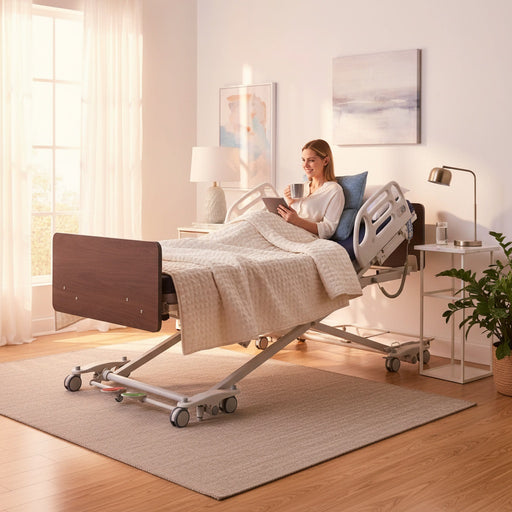
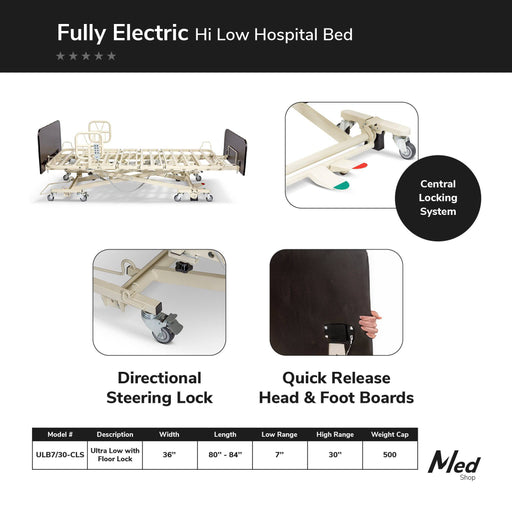
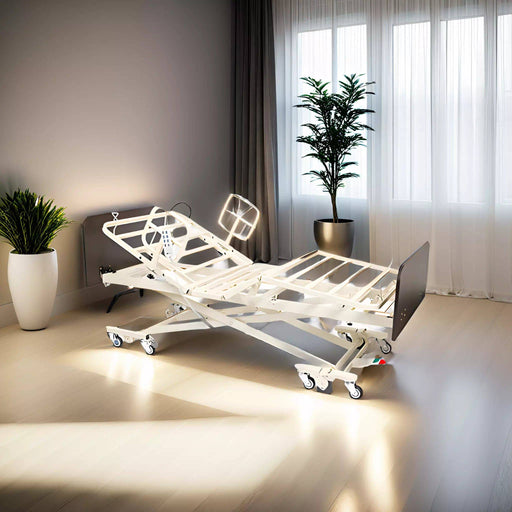


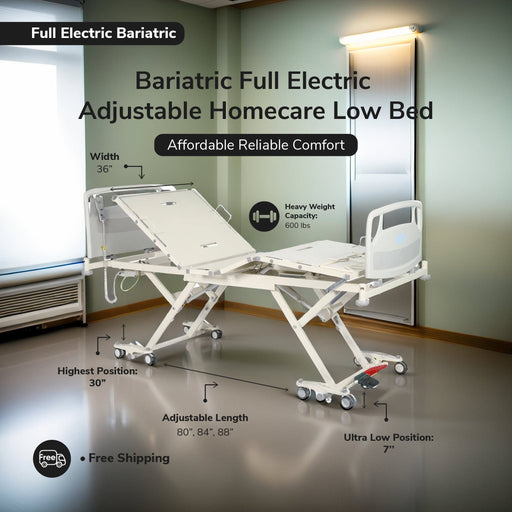
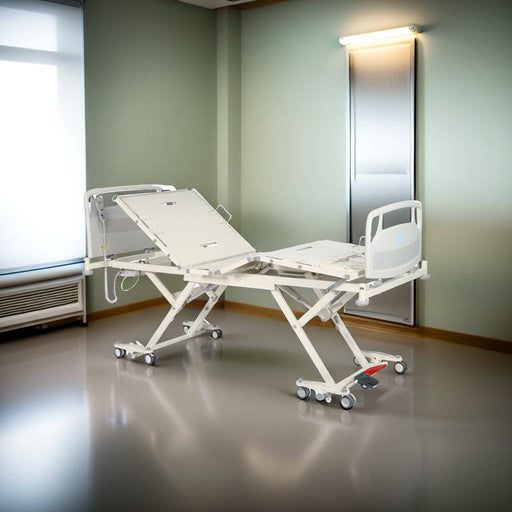
Leave a comment